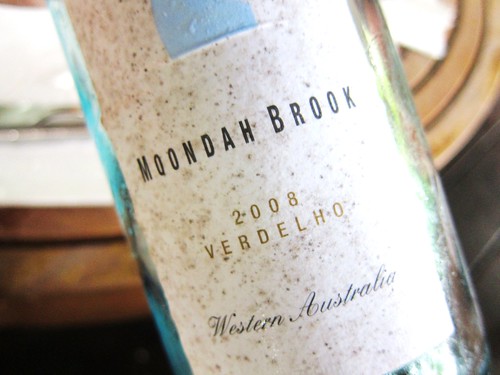 Like
many wine grapes today, Verdelho is a grape variety that is grown globally due
to the economic value of this fruit; however, it is produced on a relatively large
scale in only a few select areas. The
most traditionally recognizable wine from the Verdelho grape comes from the
Portuguese island of Madeira off the coast of Morocco where it has customarily
been wrought into a fortified medium-sweet, medium-dry wine with stonefruit aromas. It is also grown in relatively significant
amounts on the mainland of Portugal (specifically the Douro Valley in the
north), western France in the Loire Valley, Spain, California, and Australia
where the wine is truly beginning to thrive.
Like
many wine grapes today, Verdelho is a grape variety that is grown globally due
to the economic value of this fruit; however, it is produced on a relatively large
scale in only a few select areas. The
most traditionally recognizable wine from the Verdelho grape comes from the
Portuguese island of Madeira off the coast of Morocco where it has customarily
been wrought into a fortified medium-sweet, medium-dry wine with stonefruit aromas. It is also grown in relatively significant
amounts on the mainland of Portugal (specifically the Douro Valley in the
north), western France in the Loire Valley, Spain, California, and Australia
where the wine is truly beginning to thrive.
Comparable to the dissemination of other
grape varieties, it is widely believed that the Verdelho grape appears in
various countries under different names, for example Italy. It is possible that the grape originated in
Sicily due to the presence of a grape in this region called Verdello that is
almost identical genetically speaking to its Portuguese counterpart; the genetic
variations would be accounted for by the quick evolution of grape vines and their
adaptability to new environments.
 Regions with varied climates produce a
vast array of Verdelho wine flavors from apricot to mango, apple juice,
pineapple, and lemon lime all the way to white pepper. As a fortified wine from Madeira, the product
is medium-dry with a more pronounced citrus flavor, generally high acidic tang,
and elevated alcohol content. A crisp and tart dry table wine emerges from
Portugal. A sweeter, flower perfumed, and rather full bodied wine is produced
in the Central Coast. In this region,
treatment with oak increases the wine’s longevity while at the same time boosting
the grape’s aromatic qualities.
Regions with varied climates produce a
vast array of Verdelho wine flavors from apricot to mango, apple juice,
pineapple, and lemon lime all the way to white pepper. As a fortified wine from Madeira, the product
is medium-dry with a more pronounced citrus flavor, generally high acidic tang,
and elevated alcohol content. A crisp and tart dry table wine emerges from
Portugal. A sweeter, flower perfumed, and rather full bodied wine is produced
in the Central Coast. In this region,
treatment with oak increases the wine’s longevity while at the same time boosting
the grape’s aromatic qualities.
Climates were weather is too warm can
lead to an unpleasant fiery high alcohol content if the grape is picked too
late and allowed to over-ripen. Though
if picked at the right time, a warm climate enhances Verdelho’s tropical flavors
and allows the grape to thrive. On the
other hand, a cool climate enriches the herbal and citrus qualities of this
variety. A majority of internet sources
label Verdelho as a grape that ripens early, though some argue that the more
complex flavors are developed as the fruit is allowed to sit on the vine for a
little longer in the harvest season.
The Verdelho grape has become quite
prominent in Australia where the wine made turns out dry to off-dry yet maintains
a fruity richness. The diverse climates across
the country allow for as assorted collection of end products. For example Langhorne Creek, Hunter valley,
and Western Australia produce wine with a range of flavors. Western Australian wine has been described as
fruity, fresh, and “with a honeysuckle vein”.
Pineapple and guava flavors have been pegged as main descriptors for the
Langhorne Creek region. In contrast,
Hunter Valley is noted for spiciness. 
The general characteristics of the wine
tend to lean in the high alcohol and acidity range with very aromatic
qualities. Other common characteristics
include a rich, spicy, herbaceous, and tropical nuttiness. Since the grape tends to over ripen, wines
from anyone other than a master of Verdelho can often be sugary, unattractive,
flabby, fat, and broad. The wines are
hot with an alcoholic burn if picked too late.
However, the flavors of the grape mature later on in the season, so
picking too early is not a fix for the overripe issues.
Yet when picked at the right time, the
end product can be a nice complex dry wine or even a softer fruitier product! In this sweet spot range of the Verdelho
grape, a slightly earlier harvest showcases herbs and lemon citrus, while the
back end of the range highlights its rich and fruity characteristics. The dramatic and expressive qualities of
Verdelho discourage many winemakers from blending the grape; it allows a degree
of invigorating acidity that is balanced with its fruitiness.
Worldwide in 1980 the hectare coverage
of the Verdelho grape was roughly at 100.
In fifteen years that number grew to 1,500 hectares globally. Though the number is dated by eight years, I
could not find a more recent statistic.
The production of this grape has decreased in Madeira where is had
traditionally been a huge success, but Australia has been experimenting and widely
succeeding with Verdelho.
The fruit itself is relatively hard and
small with an oval shape. The clusters
are a golden yellow color and the skin is rather thick. The grapes are high in acidity preferring
rocky soils in warm dry climates.
Overall wine produced from this grape is a refreshing white that
cleanses the palate and invigorates the drinker!
Sources:
No comments:
Post a Comment